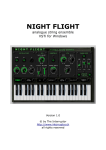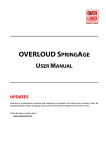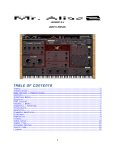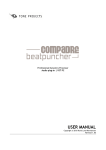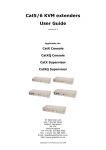Download user manual - The Interruptor
Transcript
Bionic Supa Delay Disciples Edition VST multi effects plug-in for Windows Version 1.0 by The Interruptor + The Disciples http://www.interruptor.ch Table of Contents 1 Introduction.......................................................................3 1.1 Features.....................................................................................3 2 3 4 5 System Requirements.........................................................4 License............................................................................. 4 Installation........................................................................4 General Operation..............................................................5 5.1 Fine Adjustment of a Control.........................................................5 5.2 Midi Learn...................................................................................5 5.3 Signal Flow Diagram.....................................................................5 6 Control Reference...............................................................6 6.1 6.2 6.3 6.4 6.5 Tape Delay..................................................................................6 Stereo Controls...........................................................................8 Filter..........................................................................................9 Pitch Shift.................................................................................11 Reverb.....................................................................................12 7 Program History...............................................................13 8 Credits............................................................................ 13 1 Introduction “Bionic Supa Delay” is an improved version of the popular “Bionic Delay” which is in use in many studios since over a decade. The new version was developed in a joint effort with Dub producer Russ D (The Disciples) who proposed to include additional features which are helpful for live Dub mixes. 1.1 Features • Tape delay section: ◦ high and low frequency roll-off ◦ tape wow and flutter ◦ smooth parameter for continuous delay time changes ◦ freeze function ◦ x2 button, doubles the delay time ◦ delay time is syncronized with host tempo ◦ set any delay time between tripplet and doted note timing ◦ set different delay times in left and right channel • Stereo section ◦ balance control pans the effect left and right ◦ stereo width control ◦ ping pong delay switch ◦ delays drifting from the center to the left or to the right ◦ auto panner • Filter section ◦ 12 filter types ◦ LFO to modulate cutoff frequency (host synchronized) ◦ flexible routing: before or after the delay • Pitch shift section ◦ 5 algorithms ◦ can be used also for chorus effect ◦ flexible routing: before or after the delay • Reverb section ◦ 2 reverbs A, B with different characters can be mixed ◦ flexible routing: before or after the delay • Each section can be disabled. Using the flexible routing options many different effects chains can be achieved. Examples: ◦ Send Reverb into Filter with LFO modulation BIONIC SUPA DELAY - User Manual 3 ◦ Pitch shifter inside the delay feedback loop for continuous shifts with each delay repetition • Signal flow diagram: shows the currently selected routing of the different sections • Pop-up hints help to understand the function of each control on the user interface. These appear when the mouse rests over a control. • MIDI learn: Each control can be automated via MIDI controllers. 2 System Requirements • WINXP, VISTA, WIN7, WIN8 • A host software (DAW) capable of running VST plug-ins • This plug-in runs natively on 32bit systems. If you have a 64bit system, it is likely that your DAW provides support for 32 bit plug-ins via a so called “bridge”. If this is not the case you might consider acquiring a third party bridge instead. 3 License • This software is free to use for commercial and noncommercial projects. If you use it regularly a donation is appreciated. • You are not allowed to sell the software to someone else neither on it's own nor as part of a package with other goods or services. • Redistribution for free is allowed as long as the unaltered ZIP archive including this documentation is used 4 Installation • Copy the dll file from the download archive to your VST folder • Restart your host software (DAW) • Load the plug-in Note: In case of problems please read the following. Upon starting the plug-in for the first time a number of files are automatically extracted to your VST folder. On Windows versions from VISTA onwards by default plug-ins are not allowed to write files to your 4 BIONIC SUPA DELAY - User Manual hard drive. This will typically cause an error message from your DAW reporting missing files. You can fix this issue by changing the write permissions for your VST folder as follows: • Use Windows Explorer to browse to your VST Plugins folder. • Right-click the folder – 'Properties' • Choose 'Security' tab. • Click 'Edit' button (You may need to click a UAC prompt). • Select user name "Users". • Tick options Allow 'Write' and 'Modify'. • To finish Select 'OK' to close the two dialog boxes. 5 General Operation 5.1 Fine Adjustment of a Control • Press the CTRL key while moving any control with the mouse if you need to make fine adjustments 5.2 Midi Learn • Each control can be automated via MIDI controllers. • To assign a new/different MIDI controller right-click on a control then choose "Learn" from the pop-up menu and tweak the hardware controller you want to assign. Alternatively choose "Unlearn" or "Edit.." to assign a controller from a list. The default assignement of midi controllers is documented in the pop-up hints. 5.3 Signal Flow Diagram The top panel of the user interface can be toggled between two views. Use the VU switch to enable either the VU meters or the flow diagram. The flow diagram always shows the current routing based on the selections made in the different effect sections. BIONIC SUPA DELAY - User Manual 5 6 Control Reference 6.1 Tape Delay Setting the delay time • First select a coarse delay time by - • Note buttons GROOVE TRIM x2 • • FEEDBACK pressing one of the note buttons: 1/2, 1/4, 1/8 or 1/16 notes are available. Adjust the GROOVE slider to achieve any timing between tripplet (move slider completely to the left) and dotted note (completely to the right). The middle position of the slider is the "neutral setting" which corresponds to the note button selected TRIM button: sets different delay times for the left and the right channel. In the middle position both channels have the same delay time. X2 button: doubles the delay time • Sets the amount of echo signal which is reinserted into the delay line. 6 BIONIC SUPA DELAY - User Manual DIRECT MIX • Sets the balance between the delay signal and the unprocessed input HIGH CUT LOW CUT • Simple high and low cut filters which are • FREEZE located inside the feedback path thus allowing to gradually reduce the high and low frequencies from one echo to the next Neutral position: move the high cut slider to the far right and the low cut slider to the far left • Enable this switch to keep repeating the content of the delay line without any degradation by tape saturation or eq settings. SMOOTH • Allows for smooth delay time transitions like on a tape delay when switching the motor speed. FLUTTER / WOW • Simulates tape speed imperfections • • • ON/OFF caused by the mechanical parts of the tape transport: - WOW: slow tape speed variation - FLUTTER: fast tape speed variation INT: intensity of the effect RATE: frequency of the modulation. These variations are influenced also by the SMOOTH parameter. With very high SMOOTH settings the speed variations will be evened out. If SMOOTH is disabled completely (turned counterclockwise) FLUTTER can result in audible clicks caused by instantaneous delay time changes • In OFF state the delay line is bypassed • and the feedback path including the tape saturation emulation is disabled. The remaining effect sections in the forward path remain active however: LOW CUT, HIGH CUT, FILTER, PITCH SHIFT, REVERB. You can change the order of these effects by means of the “PRE” switches located in the FILTER, PITCH SHIFT and REVERB sections. BIONIC SUPA DELAY - User Manual 7 • Look at the signal flow diagram to keep track of the routing. 6.2 Stereo Controls GENERAL • The following controls affect the Stereo output of the TAPE DELAY section BALANCE • Manual control of the stereo balance WIDTH • Controls the width of the stereo effect: - Turn fully counterclockwise for mono - Turn fully clockwise for maximum stereo separation PINGPONG • Creates echoes appearing on the left and • DRIFT right output channels alternately Note: For this effect the right input channel is muted (see signal flow diagram) • Creates echoes which gradually fade to the left or right with each repetition. This 8 BIONIC SUPA DELAY - User Manual • AUTO PAN is achieved by setting different feedback levels for the right and the left channel. The center position is neutral • Automatically balances the stereo image • • to the left and to the right using an LFO (Low Frequency Oscillator) Turn the knob to set the intensity of the effect Click on the oval-shaped control to select a time base for the LFO. The LFO is synchronized with the delay time selected in the TAPE DELAY section. Examples: x1 = one LFO cycle per delay repetition x2 = two LFO cycles per delay repetition :2 = half an LFO cycle per delay repetition 6.3 Filter ON/OFF • On: Filter enabled • OFF: Filter bypassed Setting the filter algorithm and filter type • First click on the small round control to • select Filter algorithm A or B. Then click on the oval-shaped control to select the filter type. Available Filter Types: Algorithm A = Tarrabia Filter: - LP2 = low pass, two pole - LP4 = low pass, four pole - BP = band pass - HP2 = high pass, two pole BIONIC SUPA DELAY - User Manual 9 - HP4 = high pass, four pole Algorithm B = Biquad Filter: - LP = low pass - HP = high pass - Notch - Peak - Low Shelf - High Shelf Filter controls • Algorithm A: • LFO • The LFO (low frequency oscillator) allows • • • PRE to periodically sweep the filter frequency up and down ON/OFF: enable/disable the filter LFO INT: controls the intensity of the filter sweeping RATE: Click on the oval-shaped control to select the rate of the LFO. The LFO is synchronized with the delay time selected in the TAPE DELAY section. Examples: x1 = one LFO cycle per delay repetition x2 = two LFO cycles per delay repetition :2 = half an LFO cycle per delay repetition • This switch changes the routing of the • 10 - CUTOFF = cutoff frequency - RES = filter resonance Algorithm B: - CENTER = center frequency - WIDTH = filter bandwidth - GAIN = positive or negative filter gain filter: - Disabled: Filter is located after the delay section - Enabled: Filter is located inside the feedback loop of the delay section. This can be helpful if you need more elaborate filtering in the feedback loop than just the HIGH CUT and LOW CUT Look at the signal flow diagram to keep track of the routing. BIONIC SUPA DELAY - User Manual 6.4 Pitch Shift ON/OFF • On: Pitch shift enabled • OFF: Pitch shift bypassed ALGO Select one of the pitch shifting algorithms based on your application: • B, D: suitable best for small shifts (+/- 2 semi notes) or detuning • A, C: usually better for higher shift amounts • X: Lo-Fi shift algorithm SEMI • Select the amount of semitone steps to be shifted up or down (max. +/- 24 semitones) FINE • Allows very fine pitch tuning around the • GRAIN center position of the knob. The control is scaled in a non-linear way in order to allow for large pitch shifts at the extreme left and right positions of the knob (max. +/- 2 octaves) • Sets the length of the audio snippets used by the algorithm. Generally short settings are better suited for percussive material. For melodic signals usually higher settings work best. MIX • Sets the balance between the original • PRE signal and the pitch shifted signal. Use this in combination with a very low shift amount to create a chorus effect. • This switch changes the routing of the filter: - Disabled: Pitch shift section is located BIONIC SUPA DELAY - User Manual 11 • after the delay section - Enabled: Pitch shift section is located inside the feedback loop of the delay section. This way it is possible to create echoes which are shifted continuously with each delay repetition. Look at the signal flow diagram to keep track of the routing. 6.5 Reverb ON/OFF • On: Reverb enabled • OFF: Reverb bypassed MIX AB • Fades between the two reverb algorithms: A: boingy old school reverb B: more natural sounding smooth reverb SIZE • Changes the size of the emulated room DAMP • Increasing this parameter will make the high frequencies in the reverb signal fade out faster. This is a typical behaviour for rooms with soft surfaces (wood, carpets, curtains) WIDTH • Sets the stereo width of the reverb signal MIX • Sets the balance between the original signal and the reverb signal PRE • This switch changes the routing of the reverb section: - Disabled: reverb section is located after the delay section - Enabled: reverb section is located inside 12 BIONIC SUPA DELAY - User Manual • the feedback loop of the delay section. A reverb in the feedback loop might not be the most useful setting. However as soon as you disable the delay section you can use this switch to locate the reverb before the filter, which can yield interesting results particularly if you engage the filter frequency modulation (LFO). Look at the signal flow diagram to keep track of the routing. 7 Program History • ED 1_0 - March 2014 initial release 8 Credits • Built with Synthedit by Jeff Mc Clintock http://www.synthedit.com • Third Party modules by David Haupt, Dan Worrall, Attilla Füstös, Chris Kerry • Tape saturation is provided by the freeware VST plugin “JS Magneto” developed by Dr. Schmitt: http://membres.multimania.fr/jeje1999/plug.htm • GUI controls were created using Knobman http://www.g200kg.com/en/software/knobman.html • The executable was packed using UPX http://upx.sourceforge.net BIONIC SUPA DELAY - User Manual 13













